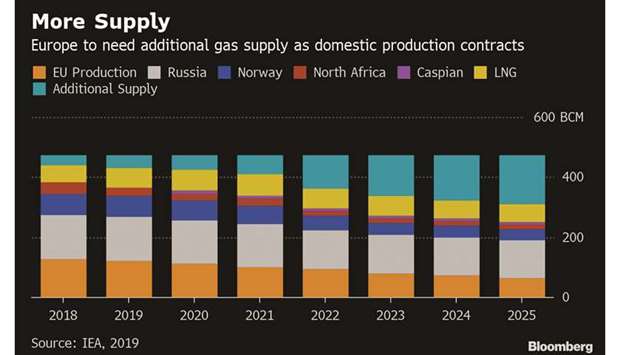The record volume of liquefied natural gas landing in northwest Europe will likely subside.
LNG imports into the region have soared since October, reaching a record last month, absorbing excess global supply following a mild winter across the Northern hemisphere. After helping push Europe’s gas prices down by more than a third this year, some cargoes may now reroute into Asia, according to executives at the annual Flame conference in Amsterdam this week.
“Prices are under pressure, but some of the LNG import will be routed to other places,” said Peder Bjorland, vice president at Norwegian producer Equinor ASA, Europe’s biggest supplier after Russia’s Gazprom PJSC. “I don’t expect a rapid recovery of prices but not necessarily the same import rate as we have seen in the last 2-3 months.”
The Norwegian exporter expects overall supplies into the region to remain high. While Equinor has some flexibility at its Troll and Oseberg fields depending on price signals, it is not changing its production and all maintenance has been planned and isn’t related to that optimisation, he said.
As the last cold leaves Europe, the question is whether there will be sufficient demand for the heating fuel. European gas consumption through the third quarter is normally driven by injections into storage but stocks are above average after the mild winter. That may see the sites fill earlier than usual and further pressure prices or even force either Russia or the US to reduce production, according to speakers at Flame.
Some of the flexible US LNG will be coming into Europe over the next one or two years, but as Asia, the biggest market for the super-chilled fuel, continues to grow, “eventually the pendulum swings back,” Gavin Thompson, who oversees energy analysis at Wood Mackenzie Ltd in the Asia Pacific, said in an interview.
If Russian and Norwegian gas pipeline flows remain at the same level and LNG keeps landing in Europe, storage sites will fill before the end of the summer, Andree Stracke, chief commercial officer at RWE AG’s supply and trading unit, said in an interview at Flame. If prices fall, that will generate demand in other markets, such as in Asia, versus other fuels.
Depending on cooling demand requirements in Asia, cargoes will be lured eastward, he said. Northwest Europe’s LNG infrastructure usage rate rose to 70% in March and April, he said, adding that he wouldn’t consider it a glut unless there was no more room for LNG.
“Now, the next month we will see a decrease of utilisation. This is because of normal maintenance in production and increase in demand in Asia,” Stracke said. “I see less cargoes coming to Europe in the next months because Asia will take more again, but it depends how the summer weather will develop.”

